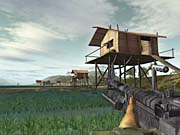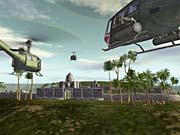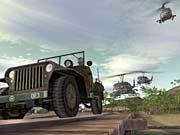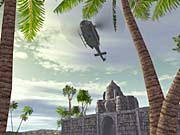Battlefield Vietnam QA
We chat with AJ Marini, lead designer at Digital Illusions, about the follow-up to Battlefield 1942.
Last year, EA Games and Digital Illusions released what has become one of the most popular online games around: Battlefield 1942. Though the game took place in gritty, real-world locations inspired by actual World War II conflicts, it also featured highly accessible, fast-paced first-person shooter gameplay and lots and lots of drivable vehicles. This proved to be a winning combination for first-person shooter fans everywhere, despite the game's regrettable technical issues at launch, as well as its lackluster single-player play. But many Battlefield fans haven't even bothered to play the game offline because the game is so enjoyable online.

It's now a year later, and GameSpot PC's multiplayer action game of the year for 2002 has been supplemented with two expansion packs. The developer has finally set its sights on making an original Battlefield game, this time based on the Vietnam War. We sat down with lead designer AJ Marini for details on this promising sequel.
GameSpot: Battlefield 1942 was pretty distinct in the variety of its locations, re-creating battles from four different WWII theaters from around the globe. Given that the Vietnam War took place in a more-limited area, can you create the same sort of variety in the maps?
AJ Marini: Although we are confined to Southeast Asia, we are fortunate that the location is a land of variety. There are, of course, jungle environments, but also mountains, cities, and river deltas.
GS: Was it a natural progression to move the series from WWII to Vietnam? Are there particular challenges to setting a game in Vietnam?
AJM: We felt it was almost an elementary decision. Following WWII, the Cold War got under way. The battle between democracy and communism was the biggest issue of the 20th century. The Vietnam War is all about this battle.
With a setting like Vietnam, there are many technical hurdles we had to overcome. The helicopters required a new physics model that was user-friendly and functional, as a helicopter should be. In other words, it had to move like a helicopter. Another challenge was the dense foliage. We had to come up with some pretty fancy tech to be able to [fill a level] with foliage without having a major drop in frame rate.
GS: The weapons and vehicles used in Vietnam were certainly more advanced than those used in World War II. How does this work into the gameplay and balance? Specifically, how do helicopters affect things?

AJM: The weapons didn't pose too much of a [design] problem, because, for the most part, they are fairly straightforward items. The helicopters, with their innate abilities, provide advantages that never existed in Battlefield 1942, like hovering next to a flag and then flying to the next point. They also offer a good measure of protection. It's rather like sitting in a flying tank, which was the focus in creating the helicopters. But humans are great problem solvers, and there are many ways to take down a helicopter. When all is said and done, the balance is still intact.
GS: How are the two sides different in the game? If the US side has superior firepower, what are some of the special advantages the North Vietnamese have?
AJM: The US doesn't necessarily have superior firepower. Each side has a complement of vehicles and weapons, and their potency is somewhat dictated by how you use them. The North Vietnamese kits are arranged a little differently, so the classes aren't carbon copies of each other. Also, NVA engineers have the ability to relocate spawn points, which gives a feeling that the NVA are coming from everywhere.
GS: Are there any fundamental changes to the game modes or victory conditions?
AJM: We didn't want to mess around too much with the win conditions for a map. It will seem really familiar to fans of the series. The biggest change is to the control points. The points take the number of soldiers around them into account. You'll need superior numbers in order to affect a control point, and the more men you have at a point, the faster [you can gain] control [of that point].
Ooh, They Point the Cannon at You!
GS: The original Battlefield 1942 has certain maps that are focused on air battles, while tanks rule in other maps. What are some of the battles you're re-creating in the new game?

AJM: When looking at the conflicts in the war, we had many to select from. We broke down what each could be in the game and then made selections based on that. We've re-created Operation Flaming Dart, which is an air battle, and the battle of the Ia Drang Valley, which is more infantry-based. We haven't settled on a final number of maps yet, but so far we have a good selection of maps with PBR fighting, infantry fighting, helicopter combat, air combat, city combat...well, you get the picture.
GS: What's new about the terrain system?
AJM: The terrain system is basically the same as Battlefield 1942. However, it is going to look completely different with the new rendering engine. We're confident that players will really feel like they're in a jungle or a Southeast Asian city.
GS: How have you incorporated the dense foliage of Vietnam into the game?
AJM: As I mentioned before, the foliage of Vietnam is one of the major hurdles we had to overcome. The [graphics system in Battlefield 1942] could not allow us to handle the sheer volume of foliage we needed to make a believable and immersive Vietnam, so we created a system that allows us to place thousands upon thousands of trees, ferns, and so on in the map. It allows us to really flesh out the maps and give the players the experience they expect.
GS: What are some of Battlefield Vietnam's technical improvements to the graphics engine?
AJM: We didn't improve the graphics engine at all. We completely threw it out and started from scratch. The aforementioned foliage system wouldn't be possible without this new engine. It's far more efficient than the original and capable of rendering far more at a greater frame rate. It also has many state-of-the-art functions built into it. For instance, the characters and vehicles that are fully normal-mapped, which makes them look like extremely high poly models without the massive poly count.
GS: We've heard there are some new special audio features. Tell us about the radio system.
AJM: The audio engine in Battlefield 1942 had issues, to say the least, so we implemented a new audio engine in the game. Many of its features are behind-the-scenes additions and also help in improving the performance of the game. One of the things that it does allow for is the new in-vehicle radio system. It allows the users to play music from their vehicles by selecting the songs from a playlist. You can change the songs anytime while piloting the vehicles. We're in the midst of finalizing the song list now, and we're very excited about the selection we have.
GS: How far along is the game?

AJM: The game is coming along nicely. It's almost like a partially constructed jigsaw puzzle. We can make out what it's going to be in the end, but there are gaps that need to be filled. We are still over six months away from our release date, and everything is going according to our immensely detailed schedule.
GS: Do you have any plans for a public beta test?
AJM: We are very fortunate to have EA's testing department at our disposal. It is very helpful. We do not have any plans for a public beta test. I'm sorry, but everyone will have to wait for the final game.
GS: Is there anything else you'd like to add about Battlefield Vietnam?
AJM: I'd just like to thank everyone for the enthusiasm they're showing for the game. It's a big motivating factor for us. We know that there are a lot of people waiting to play the game, so it gives us that boost to put in the extra effort needed to make it the best it can be.
GS: Thanks for your time.
Got a news tip or want to contact us directly? Email news@gamespot.com
Join the conversation